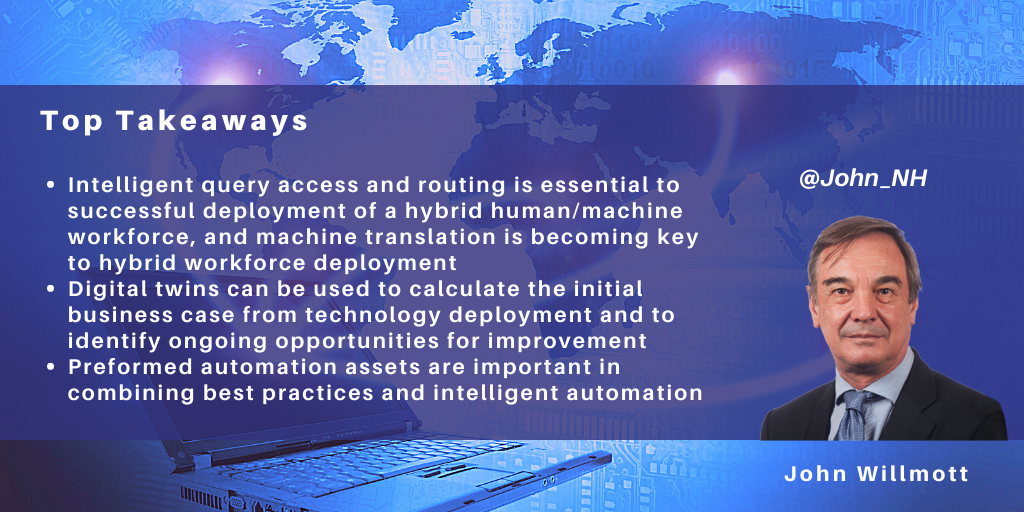Search posts by keywords:
Filter posts by author:
Related NEAT Reports
Other blog posts
posted on Mar 01, 2021 by John Willmott
Part 1 of this blog focused on Capgemini’s structured approach to workforce motivation and upskilling when transitioning to a Frictionless Enterprise that leverages a digitally augmented workforce. This second part looks at how, when adopting a digitally augmented workforce, it is critical to ensure optimized routing of incoming queries and transactions between humans and machines, and to ensure that the expected RoI is delivered from automation projects.
Intelligent Routing of Transactions between Workforce and Machines
Intelligent query access and routing is essential to successfully deploy a hybrid human/machine workforce to achieve the optimal allocation of transactions between personnel and machines. For example:
- For a North American manufacturer, Capgemini combined RPA with multiple microservices from AWS and Google and Capgemini code to classify 41 categories of incoming accounts payable queries. If a classification is possible, the query is allocated either to a human or machine. Queries that go the machine route have their text analyzed using NLP, and actions are then triggered to collect the information necessary to answer the query. If the confidence level in the response exceeds 95%, the answer is sent automatically. If not, then the query and response are sent to a human for review and confirmation. This is an example of a digitally augmented workforce
- For another client, Capgemini reduced the cost per query of procure-to-pay queries from 180 cents to 17 cents by using a digitally augmented workforce. The company’s AI Query Classifier uses NLP and ICR to extract the relevant information from the unstructured text, validate the query and automate ticket creation. Its AI Workload Distribution then orchestrates the process and decides whether each case goes through automated or human resolution
- Elsewhere, a client had a large team serving billable transactions in 24 languages, but 30%-40% of the transactions they received were not relevant to this team. Capgemini implemented 90% automated identification & indexing for 21 of these 24 languages. The data is validated, further data retrieved where necessary, and then the data revalidated. Business rules are then applied to identify whether the transaction is handled manually or automated. Savings of ~75% of the total effort were achieved.
The use of machine translation is becoming increasingly important in these situations, and Capgemini is now working on machine language translation to reduce its dependency on nearshore centers employing large numbers of native speakers in multiple languages.
Preformed automation assets are also important in combining best practices and intelligent automation. Here, Capgemini has introduced 890 by Capgemini. This catalog of analytics services enables organizations to access analytical and AI solutions and datasets from within their own organization, from multiple curated third-party providers, and from Capgemini. Capgemini has focused on the provision of sector-specific solutions and currently offers ~110 sector solutions.
Introduction of Digital Twins Ensure Delivery of RoI from Technology Deployment
Capgemini’s approach to data-driven process discovery and excellence is based on combining process mining using process logs, task capture and task mining using desktop recorders, productivity analytics for each individual, and use of digital twins.
Tools used include Fortress IQ, Celonis, and Capgemini’s proprietary Prompt tool. These tools are combined with Capgemini’s Digital Global Enterprise Model (D-GEM) platform to incorporate best-in-class processes and frictionless processing.
Digital twins are used to progress process discovery beyond digital snapshots and provide ongoing process watching, assessment, and definition of opportunities. It also allows Capgemini to simulate the real returns that will be achieved by the introduction of technology by highlighting any other process constraints that will be exposed and limit the expected RoI from automation initiatives.
Capgemini’s approach to process digital twin introduction is:
- To start with business mining, a combination of process mining, task mining, and Capgemini’s D-GEM platform
- This is followed by benchmarking the processes against D-GEM
- Then simulating the impact of introducing technology, calculating the business case, and ensuring that the result achieved is close to what was anticipated by identifying any potential process bottlenecks that might reduce the technology deployment’s savings. These simulations also help in accelerating the approval of intelligent automation projects and the scaling of digital transformation within the enterprise, since they increase management confidence in the certainty of project outcomes
- This is followed by continuous improvement and identifying ongoing areas for improvement.
Also, during the pandemic, it is increasingly difficult to run onsite workshops for automation opportunity identification. It is becoming increasingly necessary to use digital twin process mining of individuals’ machines to remotely build business cases. This development may become standard practice post-pandemic if it proves to be a faster and more reliable basis for opportunity identification than interviewing SMEs.
Conclusion
In conclusion, the deployment of technology is arguably the easy part of intelligent process automation projects. Two more challenging elements have always been interpreting and routing unstructured transactions and queries and identifying and delivering RoI. Capgemini’s Frictionless Enterprise approach – that leverages a digitally augmented workforce – addresses both these challenges by combining technologies for classification and routing unstructured transactions and queries, and introducing process digital twins to ensure RoI delivery.
You can read Part 1 of this blog here.

